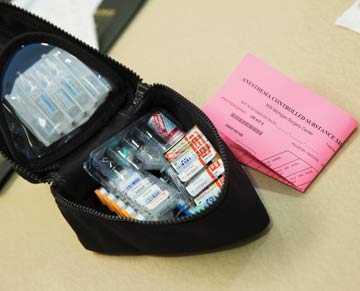Instead of discarding unused fentanyl in real time, your anesthesia provider aggregates all discards and brings them out for witnessing by another licensed professional at the end of each day. Sounds like an efficient way to handle discards, right? Wrong.
Here’s the issue: Potential drug diverters may see this process as an opportunity to substitute the fentanyl for a substance like saline. At the end of the day, the witness will only see clear liquid and have no way of discerning the actual contents within.
Thanks in large part to the opioid crisis, your controlled substance practices are under the microscope. Documentation is your best friend here. You need to create an easy-to-follow trail of controlled drug withdrawal from the PACU to the ORs each day, with documentation of the when — and by whom (at least 2 licensed individuals).
To prevent diversion, you’ll want to ensure a licensed individual witnesses discards of partial portions of any controlled substance. Both the discarder and witness should sign off at the time of discard. You should also validate a count of the controlled drug cabinet at the beginning and end of each day.
Many facilities keep their controlled substances in a safe as well as in a PACU cabinet. Your safe will ultimately stave off diverters. First, you’ll need to ensure the safe is appropriately protected and that only a few (I recommend no more than 3) authorized individuals have access to the combination. Generally, this is the clinical director, PACU manager or the “pharmacy nurse” and the medical director or the holder of the controlled drug registration certificate. You’ll also need to ensure the count — a count that should always include expired drugs — within the safe is validated and documented at least monthly or upon the withdrawal of the medication for facility distribution. But keep in mind, some states require more frequent validation/documentation.
When it comes to controlled substances, you should also make every effort to minimize stocking various strengths of drugs. How? Adjust the formulary as much as possible to minimize the calculations of drugs on hand and the potential for error. Many medication errors, especially those involving pediatric patients, are the result of a provider or medication administrator using the wrong strength of a controlled substance. These potentially catastrophic mistakes can be greatly reduced (if not eliminated) through a bare minimum approach to stocking various strengths of drugs. However, this can be difficult — particularly with pediatrics and certain classes of drugs such as anesthetic injectables. If multiple strengths of drugs are essential, distinct “Look-Alike/Sound-Alike” (LASA) drug auxiliary labels, different color narcotic-use forms and separation in storage areas are all proven error-reducing tactics.
.svg?sfvrsn=be606e78_3)

.svg?sfvrsn=56b2f850_5)